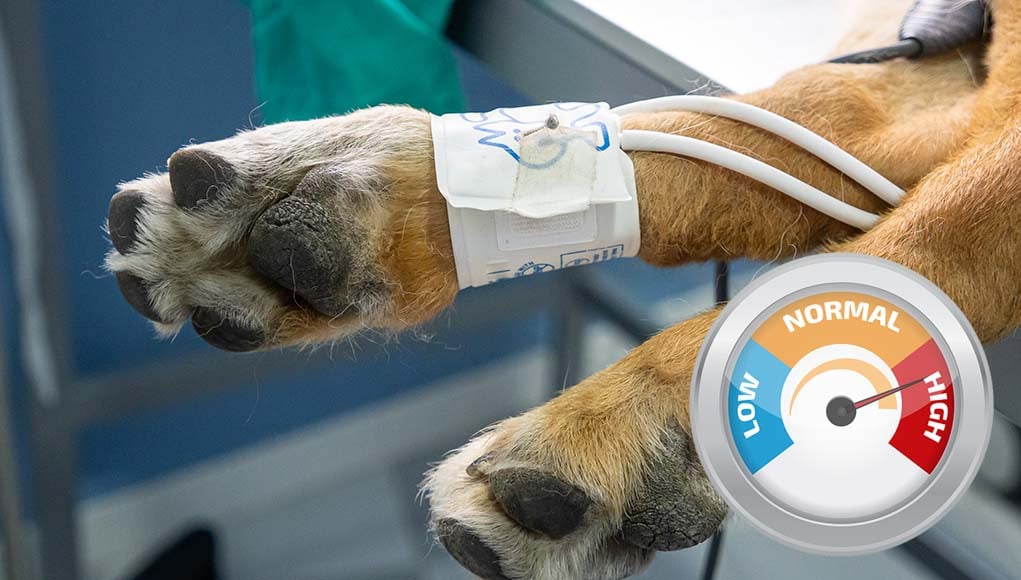High blood pressure in dogs can negatively affect how your pooch functions in their daily life.
Just like in humans, various health conditions can cause hypertension in dogs.
On the other hand, this condition can also occur naturally or may be triggered by an external source or underlying cause.
Your dog will experience different symptoms depending on their age and if they have any other ailments.
In this article, we will discuss what hypertension could really mean in your Fido, how to spot the symptoms, and what you can do to manage high blood pressure in dogs.
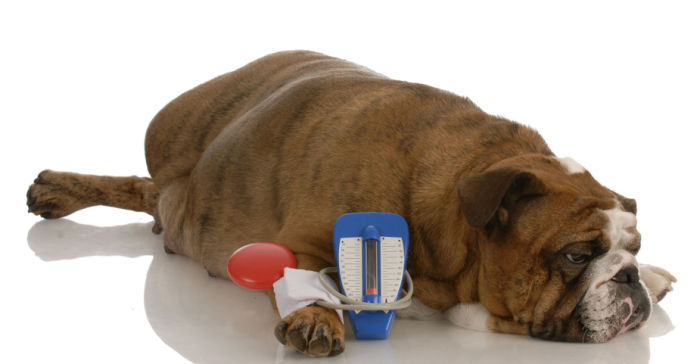
What Exactly is High Blood Pressure in Dogs?
High blood pressure in dogs is also known as hypertension.
It is when the blood pressure of the animal elevates past a number that is expected of this species or what has been determined to be the species' average.
Dogs that have a systolic blood pressure higher than 150 mmHg are at risk for health complications and issues.
Hypertension that affects the dog in this way requires further medical attention and treatment.
To have an accurate blood pressure reading, the highest and lowest numbers gathered will be removed, and the rest will be averaged.
These will include any blood pressure measurements taken throughout the entirety of the dog's body.
When measuring high blood pressure in humans, we use systolic blood pressure/diastolic blood pressure.
They're the pressure following the ejection of blood from the heart and the pressure before the removal of blood from the heart.
However, when measuring high blood pressure in dogs, we typically only use the top number or the systolic blood pressure.
Types Of High Blood Pressure in Dogs
The two types of high blood pressure that affect dogs are primary and secondary hypertension.
Both types are more or less common in different species and should be considered when diagnosing the dog.
Primary Hypertension
Primary hypertension is when the dog has high blood pressure, but there is no underlying cause.
Dogs rarely suffer from this type of hypertension, but it is the most common type in humans.
Secondary Hypertension
Secondary hypertension is when the dog has high blood pressure caused by an underlying disease.
This is the most common type of hypertension in dogs and should be the first assumption of the vet.
They should immediately look to discover the underlying disease and create a treatment plan accordingly.
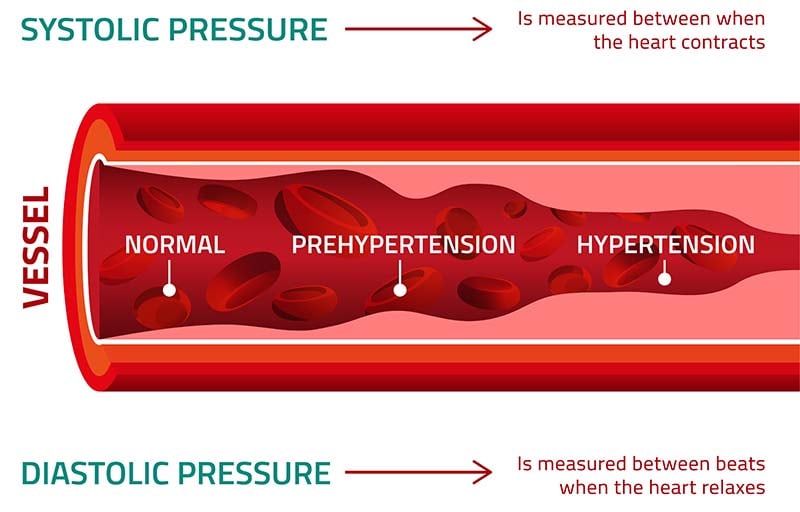
Symptoms of High Blood Pressure in Dogs
Checking for high blood pressure in dogs is easy for a veterinarian, but owners should learn to recognize the small signs that their dog may be displaying caused by high blood pressure.
These signs are not always obvious and are usually hidden in their behavior and physical appearance.
The signs associated with high blood pressure in dogs most often involve the pet's heart, kidneys, eyes, and central nervous system. These symptoms may include:
- Bleeding of the eyes
- Retinal detachment
- Congestive heart failure
- Coughing
- Shortness of breath
- Labored breathing
Neurological symptoms are most often caused by a stroke related to the dog's development of hypertension.
They may change or vary based on the part of the dog's brain that was affected. These symptoms may include:
- Changes in walking pattern
- Loss of balance
- Loss of sight
- Change or reduction of mental activity
Owners should also be on the lookout for signs of the kidneys malfunctioning or failing.
Hypertension in dogs frequently leads to kidney failure, so it is critical that these signs and symptoms be identified as soon as possible.
These symptoms include:
- Protein in urine
- Increased drinking
- Vomiting
- Lethargy
- Poor appetite
- Increased urination
Most early signs of your dog's high blood pressure are asymptomatic, meaning that the dog does not necessarily show any signs of being sick (Littman, et al. 1988).
Early signs can be misinterpreted as normal changes in the animal caused by the aging process. This includes the dog slowing down and not eating well.
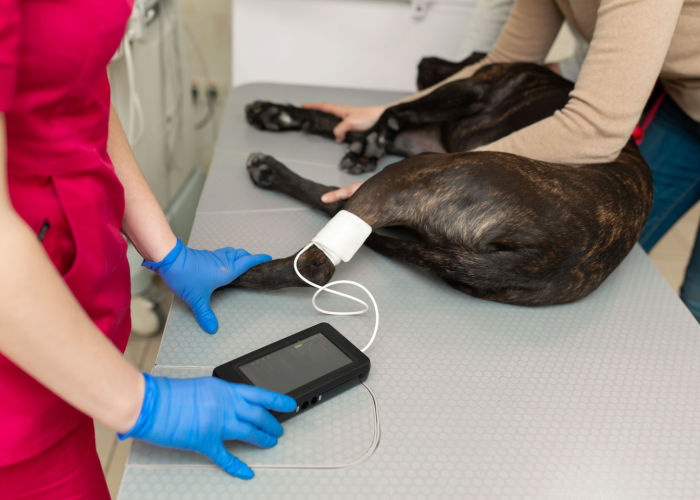
How high blood pressure affects other organs in dogs
Other organs may be negatively affected by hypertension in dogs or associated conditions:
| Organ | Effect of Hypertension | More Likely If… |
| Kidneys |
|
If SBP > 160 mmHg |
| Eyes |
|
If SBP > 180 mmHg |
| Brain |
|
If SBP > 180 mmHg |
| Heart |
|
Unknown |
Causes of Dog's High Blood Pressure
As the most common type of high blood pressure is secondary hypertension, most situations involve the dog having an underlying disease.
High blood pressure is frequently associated with:
- Chronic renal (kidney) disease
- Glomerular disease (protein/kidney disease)
- Cushing's disease (hyperadrenocorticism)
- Endocrine disease
- Growth hormone overproduction (Acromegaly)
- Diabetes mellitus
- An adrenal tumor (pheochromocytoma)
- An abnormal increase in the number of red blood cells in the circulatory system (polycythemia)
The risk of high blood pressure can increase depending on the dog's breed. Studies observed that the following breeds are more predisposed to Cushing's disease:
- Poodles
- Dachshunds
- Multiple terrier breeds
And these breeds are more likely to suffer from diabetes mellitus:
- Schnauzers

- Australian terriers
- Bichon frises
- Spitz dogs
Having high blood pressure is not only related to such underlying diseases that are common in certain breeds but also general high blood pressure that occurs naturally without the disease.
This frequently happens in Sighthounds that primarily hunt by speed and sight rather than scent and endurance like Scent Hounds.
Health also plays an essential part in developing (and preventing) high blood pressure in dogs.
Animals that are most athletic are less likely to develop high blood pressure.
Dogs that are overweight and unhealthy are more likely to develop high blood pressure.
Checking for High Blood Pressure
After identifying any possible symptoms of high blood pressure, such as becoming restless or losing weight, make a trip to the vet.
Make an appointment to have the dog seen as soon as possible and compile a list of concerns that you may have about the dog's behavior and health. The vet will then work towards making an appropriate diagnosis.
High blood pressure is diagnosed when the dog is suffering from persistent systolic blood pressure that is greater than or a squeak to 160 mmHg.
Like humans, this pressure is determined by the dog's blood pressure which can be measured by using the oscillometric or the doppler ultrasonographic method.
These methods are similar to those used to diagnose humans.
Although the vet may take the dogs' blood pressure, and it is confirmed high, they will not say it is hypertension until checking 2-3 additional times.
This typically occurs once when the dog arrives at the vet's office and again with the owners in the room.
Next, they will eliminate stress as the cause of their high blood pressure and verify that there may be an underlying condition.
To check blood pressure, an inflatable cuff is fit around the dog's foreleg or tail and is inflated to determine the blood flow through the artery.
This is what it looks like:
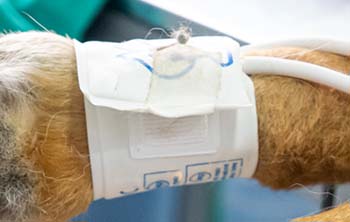
It is because a stethoscope is not sensitive enough to detect the blood flow, and an ultrasonic probe must be taped or held over the artery, and the sound of the systolic pressure is then converted into an audible signal.
How Common is High Blood Pressure Among Dogs?
High blood pressure or hypertension is not common in dogs and is found only 10% of the time in healthy dogs (Bodey et al. 1996).
This means that regular screening is not required and is unnecessary.
Only dogs that have an existing condition associated with the development of high blood pressure should have a blood pressure measurement performed.
High blood pressure in dogs is more common for those with renal failure or kidney failure, with a study showing that 93% suffered from high blood pressure (Acierno et al., 2018).
However, dogs that are already ill may need to have their blood pressure checked regularly, sometimes as often as daily.
It's part of The Rule of 20 – a veterinarian's list of important parameters, all of which should be closely looked at every day in very sick dogs, and blood pressure checks are one of them.
Additionally, dogs that are being fed the wrong types of food or are not receiving the proper nutrition are more likely to suffer.
High blood pressure may also be the result of the dog taking certain types of medication.
Overall, high blood pressure is not as common in dogs as it is in humans.
Typically, high blood pressure does not stand on its own, making it less likely to develop randomly.
With fewer situations where it would become an issue, it is one of the least common ailments a dog may suffer from.
Food and Nutrition for High Blood Pressure
Certain foods are likely to raise blood pressure in dogs.
For example, foods that are high in sodium and potassium content may cause high blood pressure in some dogs.
However, salt should not be completely removed from your dog's diet. The proper amount of salt within the dog's diet has yet to be established.
Also, high-fat diets that are not providing adequate nutrition can contribute to higher blood pressure levels in dogs.
With that in mind, a hypertensive dog will benefit from a
low-salt and low-fat diet.
And since hypertension in dogs is mostly caused by an underlying disease like kidney disease, giving them food fit for it can help in their condition.
Remember that a proper and balanced diet is almost always key in managing different diseases, just like high blood pressure in dogs.
RELATED: Recipe: Simple and Quick Homemade Dog Food for Kidney Disease
Best Medication for High Blood Pressure in Dogs
Unfortunately, all blood pressure medication for dogs comes with some potential side effects, both long-term and short-term.
The amount of which they affect the dog varies from case to case.
With high blood pressure or hypertension, there are a few medications that commonly cause or are related to its development.
Some examples of such medications to treat high blood pressure in dogs include:
- Angiotensin-converting enzyme inhibitors
- Enalapril
- Benazepril
- Calcium channel blockers
- Amlodipine
- Adrenergic blockers
- Phenoxybenzamine
- Prazosin
With Regards to Older Dogs…

High blood pressure is frequently found in older dogs, as they are more likely to have additional health problems.
High blood pressure is often a symptom of an underlying disease, and senior dogs tend to suffer more and have diseases that go unnoticed for longer periods of time.
However, while some studies associated older age directly with higher blood pressure, most recent research found no correlation between the age of the dog and raised blood pressure (Remillard, et al. 1991; Stepien, et al. 1999).
It is uncertain whether when high blood pressure is controlled if it extends the lifetime of the dog or not, but there's currently some research done in that area.
FAQs on High Blood Pressure in Dogs
What is normal blood pressure in dogs?
Nothing to worry about if your dog's systolic blood pressure reading measured below 150mmHg—that's completely normal for them!
However, if his systolic blood pressure read 160mmHg, that's already considered pre-hypertension. It might be best to start working with your veterinarian to manage it ASAP.
Hypertension in dogs will be diagnosed if their systolic blood pressure reading is consistently at 180mmHg or above.
Can a dog parent check a dog's blood pressure at home?
It is not advisable to use a blood pressure testing device intended for humans to measure and monitor a dog's blood pressure.
The best way still is by bringing your dog over to the vet immediately.
This way, you'll be assured that the process of getting their blood pressure measurement will be efficient, the reading will be accurate, and your dog will get the immediate attention he requires in case the need arises.
Does high blood pressure in dogs cause panting?
Excessive panting, especially among middle-aged or senior dogs, may be associated with hypertension.
Although high blood pressure in dogs occurs mostly because of other diseases (Cushing, kidney, renal, etc.,) panting excessively should definitely not be overlooked.
Check for other possible symptoms, list them down, and report to your veterinarian for a quicker diagnosis.
How long can dogs live with hypertension?
Just like with other chronic diseases, guessing or estimating the life expectancy of dogs with hypertension is difficult.
The prognosis for hypertensive dogs varies, like in humans. It depends on their current health status and the underlying disease that's causing it.
But with proper care, monitoring, and medications, dogs with high blood pressure can live comfortably for years to come.
And don't worry—many dogs with this condition have responded well to treatments.
Is blood pressure monitoring part of a healthy dog's regular veterinary visit?
No, blood pressure monitoring is usually not part of a regular vet visit, for the most part.
Measuring a dog's blood pressure is actually more like an ala carte service that vets and vet clinics offer. They only do this if there are possible causes, like underlying diseases, that could spike the blood pressure of your pet.
The reason behind this is primary hypertension in dogs is not common (as discussed above.) They don't get diagnosed with only high blood pressure.
What dogs usually get is secondary hypertension.
Dogs are diagnosed with secondary hypertension because of an underlying disease.
The second reason why blood pressure monitoring isn't a part of vet routine visits is the high incidence of false positives.
Dogs also suffer from anxiety because of vet visits (the same way we get anxious visiting doctors!) which could also spike their blood pressure.
High Blood Pressure in Dogs – Final Thoughts
In conclusion, high blood pressure in dogs really does happen, and it's something pet owners should take seriously and mitigate as soon as possible.
It's manageable as long as you get the proper and immediate support and guidance from the experts.
And even though you know how to read blood pressure in humans, getting a dog's blood pressure is a different story. It's always best to leave that to the experts.
What you can do, though, as a pet parent is to observe your dog closely, list down the unusual symptoms you're seeing, and report that to your trusted veterinarian.
That way, you and your vet can work efficiently and develop a treatment plan for the betterment of your Fido.
READ NEXT: Low Blood Sugar in Dogs – What Owners Should Know


